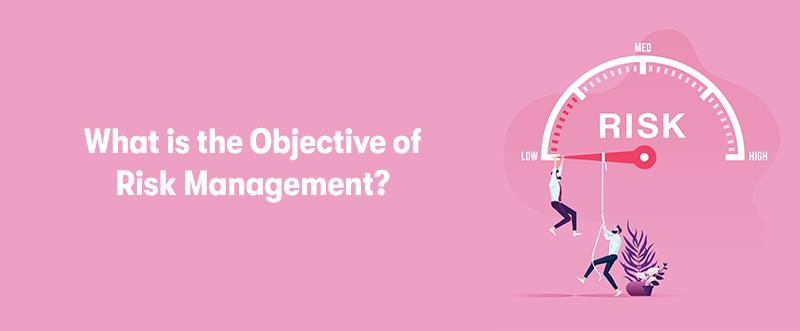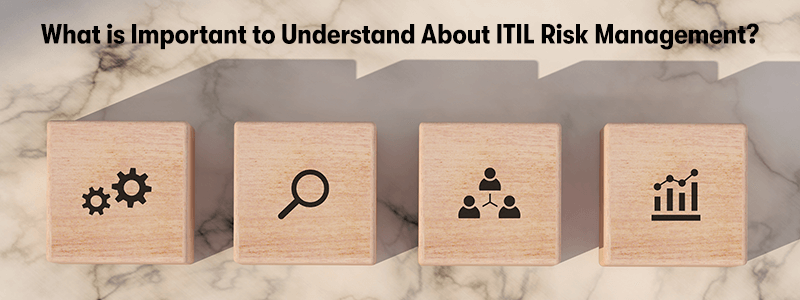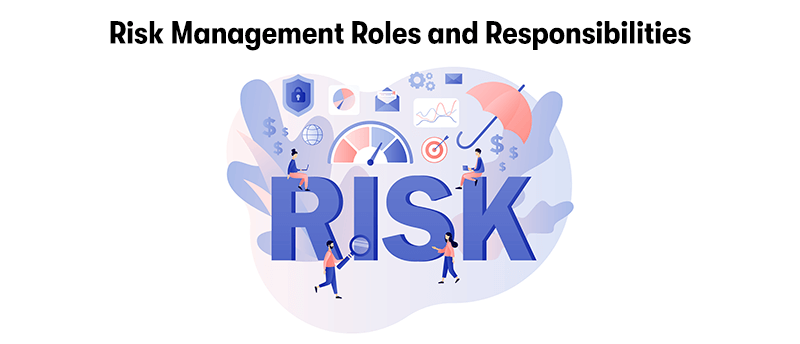ITIL® Risk Management
ITIL 4 risk management is a crucial aspect of the ITIL 4 methodology, which serves as a comprehensive framework for IT service management. The primary goal of ITIL 4 risk management is to identify, assess, and manage risks associated with IT services and processes in order to ensure business continuity, protect value, and enhance overall service quality.
The process of ITIL 4 risk management begins with the identification of potential risks that could impact IT services, processes, or projects. This involves gathering information about various aspects of the organisation's IT environment, such as technology, security, compliance, and people-related factors. Once risks are identified, they undergo assessment to determine their potential impact and likelihood of occurrence. This risk assessment helps prioritise risks based on their significance and potential consequences to the organisation.
The next step is risk analysis, where each identified risk is examined in-depth to understand its root causes, potential consequences, and possible ways to address or mitigate it. Subsequently, the organisation evaluates its risk tolerance level and decides whether some risks can be accepted if they fall within acceptable thresholds or if they require active treatment.
Based on the risk evaluation, appropriate risk treatment strategies are selected and implemented. These strategies may include risk avoidance, risk reduction, risk sharing, risk transfer, or risk acceptance. The effectiveness of the risk treatment measures is continuously monitored and reviewed to ensure their ongoing relevance and adaptability to changing circumstances.
ITIL 4 risk management is integrated into various ITIL practices and processes, becoming an intrinsic part of decision-making, change enablement, incident management, and other IT service management activities. By doing so, risk considerations are consistently applied throughout the ITIL methodology, aligning IT service management with the organisation's business objectives.
What is ITIL Risk Management?

ITIL 4 defines risk management as a crucial part of the service value system, which helps organisations identify, assess, and manage risks associated with their IT services and processes. The purpose of risk management in ITIL 4 is to enable your organisation to make informed decisions about how to address and mitigate risks effectively, while still achieving its objectives and providing value to its stakeholders.
The key components of ITIL 4 risk management are as follows:
Risk Identification
This step involves identifying and documenting potential risks that could impact the organisation's IT services, processes, or projects. These risks can be related to technology, security, compliance, people, or any other relevant area.
Risk Assessment
After identifying the risks, they are assessed to understand their potential impact and probability of occurrence. This step helps prioritise risks based on their significance.
Risk Analysis
The analysis phase involves a deeper examination of each risk to understand its root causes, potential consequences, and possible ways to address or mitigate it.
Risk Evaluation
In this step, organisations evaluate the identified risks to determine their tolerance level. Some risks may be accepted if they fall within acceptable thresholds, while others might require more proactive treatment.
Risk Treatment
Risk treatment involves selecting and implementing appropriate strategies to address the identified risks effectively. These strategies may include risk avoidance, risk reduction, risk sharing, risk transfer, or risk acceptance.
Risk Monitoring and Review
Once the risk treatment strategies are in place, ITIL 4 emphasises the importance of continuous monitoring and review of risks to ensure their effectiveness. This step helps in identifying any changes in risk conditions and adapting the risk management approach accordingly.
Integration with ITIL Practices
ITIL 4 risk management is integrated into various ITIL practices and processes to ensure that risk considerations are consistently applied across the organisation.
What is the Objective of Risk Management?

The objective of ITIL 4 risk management is to enable organisations to proactively identify, assess, and effectively manage risks associated with their IT services, processes, and projects. By incorporating risk management into the IT service management (ITSM) practices, ITIL 4 aims to achieve the following goals:
Protecting Business Value
The primary objective of ITIL 4 risk management is to safeguard the business value and ensure that IT services and processes continue to deliver value to customers and stakeholders despite potential risks. By addressing risks before they escalate, organisations can minimise disruptions and protect their reputation.
Minimising Disruptions
Effective risk management helps in reducing the likelihood and impact of potential disruptions to IT services. This ensures that businesses can maintain continuity, meet service level agreements (SLAs), and avoid costly downtime.
Optimising Decision-Making
Risk management provides decision-makers with valuable insights into potential risks and their potential consequences. This information allows them to make informed decisions about resource allocation, prioritisation, and risk treatment strategies.
Enhancing Resilience
By actively managing risks, organisations can build greater resilience into their IT services and overall operations. Resilience allows businesses to respond and recover more effectively from adverse events and incidents.
Complying with Regulations
Many industries have strict regulatory requirements related to data security, privacy, and service quality. Risk management in ITIL 4 helps organisations stay compliant with these regulations by addressing risks that could lead to non-compliance.
Improving Resource Management
By understanding and managing risks effectively, organisations can optimise the use of resources, ensuring that they are allocated where they are needed most to address potential risks and achieve business objectives.
Supporting Continuous Improvement
ITIL 4 emphasises the concept of continuous improvement, and risk management plays a vital role in this process. By monitoring and reviewing risks, organisations can identify areas for improvement in their ITSM practices and make necessary adjustments.
Building a Risk-Aware Culture
Integrating risk management into ITIL practices helps foster a risk-aware culture within the organisation. Employees at all levels become more conscious of potential risks and are encouraged to take proactive measures to mitigate them.
Overall, the objective of ITIL 4 risk management is to enable organisations to navigate uncertainties and challenges effectively while ensuring the delivery of reliable and high-quality IT services to meet the needs of their customers and stakeholders.
Why is Risk Management Important in ITIL?

Risk management is of significant importance in ITIL 4 for several reasons:
Preserving Business Continuity
IT services are critical to the functioning of modern businesses. Risk management helps identify potential threats that could disrupt services, allowing organisations to take preventive measures and maintain business continuity.
Minimising Service Disruptions
By proactively identifying and addressing risks, ITIL helps minimise service disruptions, ensuring that IT services meet the agreed-upon service levels and deliver consistent value to customers.
Protecting Reputation
Service disruptions or data breaches can severely impact an organisation's reputation. Effective risk management in ITIL reduces the likelihood of such incidents, helping maintain the organisation's image and credibility.
Compliance and Governance
Many industries are subject to strict regulatory requirements. ITIL's risk management practices ensure that organisations comply with relevant regulations, avoiding potential penalties and legal issues.
Cost Optimisation
Unplanned incidents and disruptions can be costly to resolve. Risk management helps allocate resources effectively, allowing organisations to focus on addressing higher-priority risks and optimising resource utilisation.
Supporting Decision-Making
Identifying and assessing risks provides valuable information to decision-makers. This data-driven approach supports informed decision-making about IT service investments, priorities, and risk treatment strategies.
Encouraging Proactive Behaviour
By embedding risk management into ITIL processes, organisations cultivate a culture of proactive risk management. Employees become more aware of potential risks and are encouraged to take actions to prevent or mitigate them.
Enhancing Resilience
ITIL's risk management practices promote building resilience into IT services and operations. Organisations can better withstand unexpected events and recover more quickly from incidents.
Aligning IT with Business Objectives
Risk management ensures that IT services are aligned with the organisation's overall business objectives. By understanding risks and their potential impacts on the business, IT can prioritise efforts that support business goals.
Supporting Continuous Improvement
ITIL emphasises continuous improvement, and risk management plays a crucial role in this process. By continuously monitoring and reviewing risks, organisations identify areas for improvement in their ITSM practices.
Promoting Accountability
Risk management in ITIL encourages accountability at all levels of the organisation. Teams take ownership of identified risks, and stakeholders collaborate to address and mitigate them effectively.
Overall, risk management is essential in ITIL to provide a structured and systematic approach to dealing with uncertainties, vulnerabilities, and potential threats. It helps organisations maintain stable IT services, reduce operational and financial risks, and improve their overall service delivery capabilities.
What is Important to Understand About ITIL Risk Management?

Understanding ITIL risk management involves several key points that are important to grasp:
Integration with ITIL Framework
ITIL risk management is an integral part of the ITIL framework for IT service management. It should be implemented alongside other ITIL practices, processes, and guiding principles to ensure a holistic approach to risk management.
Proactive Approach
ITIL risk management emphasises a proactive approach rather than a reactive one. Identifying and addressing risks before they escalate helps prevent potential incidents and disruptions to IT services.
Contextual Relevance
Risk management in ITIL should be tailored to the specific context of the organisation, considering its objectives, business processes, industry, and regulatory environment. There is no one-size-fits-all approach to risk management.
Risk Assessment and Analysis
Effective risk management involves thorough risk assessment and analysis. This includes identifying risks, evaluating their potential impact and likelihood of occurrence, and understanding the root causes and potential consequences of each risk.
Risk Treatment Strategies
ITIL risk management offers various risk treatment strategies, such as risk avoidance, risk reduction, risk sharing, risk transfer, and risk acceptance. Selecting the most appropriate strategy depends on the organisation's risk tolerance and business objectives.
Risk Monitoring and Review
Risk management is not a one-time activity. ITIL emphasises the importance of continuous monitoring and review of risks to ensure that the chosen risk treatment strategies remain effective and relevant.
Decision Support
The insights gained from risk management activities should support decision-making processes at all levels of the organisation. Data-driven risk assessments help in resource allocation, prioritisation, and determining the most effective risk treatment measures.
Risk-Aware Culture
ITIL encourages building a risk-aware culture within the organisation. All stakeholders should be conscious of potential risks and collaborate to address and mitigate them effectively.
Communication and Collaboration
Effective risk management in ITIL requires open communication and collaboration among various teams, departments, and stakeholders. Transparent sharing of risk information helps in collective risk management efforts.
Continual Improvement
Like other ITIL practices, risk management is subject to continual improvement. Organisations should regularly evaluate the effectiveness of their risk management processes and make necessary adjustments based on lessons learned and changing circumstances.
Documentation and Reporting
ITIL risk management requires proper documentation of risk assessments, treatment plans, and outcomes. Regular reporting on risk status and the effectiveness of risk treatment measures is essential for organisational visibility and accountability.
Resilience and Business Value
Ultimately, the primary goal of ITIL risk management is to enhance the resilience of IT services and protect the business value they deliver. By understanding and addressing risks effectively, organisations can ensure they are better prepared to navigate uncertainties and challenges.
Understanding these key aspects of ITIL risk management helps organisations implement a robust risk management approach, align it with business goals, and improve the overall stability and reliability of their IT services.
Risk Management Roles and Responsibilities

In ITIL 4, risk management involves various roles and responsibilities to ensure effective identification, assessment, and management of risks within an organisation's IT service management processes. The key roles and their associated responsibilities include:
Risk Owner:
- Responsibility for identifying, understanding, and managing specific risks related to IT services or processes.
- Defining risk treatment plans and strategies to address identified risks.
- Ensuring that appropriate actions are taken to mitigate or resolve risks.
- Monitoring the effectiveness of risk treatment measures and adjusting them as needed.
- Reporting on the status of risks and risk management efforts to relevant stakeholders.
Risk Coordinator:
- Assisting the risk owner in coordinating risk management activities and processes.
- Collaborating with different stakeholders to collect risk-related information.
- Maintaining documentation related to risks, assessments, and treatment plans.
- Facilitating risk review meetings and discussions.
- Supporting the risk owner in monitoring and reviewing risk management efforts.
Service Owner:
- Owning the overall delivery and performance of specific IT services.
- Collaborating with the risk owner to understand and address risks that may affect the service's delivery or value.
- Participating in risk assessment and treatment discussions related to the service.
- Ensuring that the service's risks are considered in the service strategy, design, and improvement processes.
Process Owner:
- Owning and overseeing the execution of specific ITIL processes.
- Identifying risks associated with the process and ensuring they are appropriately managed.
- Collaborating with the risk owner and service owner to address process-related risks.
- Continuously improving the process to enhance risk management and overall efficiency.
Change Manager:
- Assessing the potential risks associated with proposed changes to IT services or infrastructure.
- Collaborating with the risk owner to understand the risk impact of changes and ensure they are effectively managed.
- Evaluating change-related risks to determine whether changes can be safely implemented.
Service Desk and Support Staff:
- Being aware of potential risks and issues reported by users and customers.
- Escalating risk-related incidents or concerns to the relevant risk owner or coordinator.
- Assisting in identifying and documenting risks related to service incidents or problems.
IT Management and Leadership:
- Providing support and resources for risk management activities.
- Ensuring that risk management is integrated into the organisation's IT strategy and decision-making processes.
- Reviewing and approving risk treatment plans and strategies proposed by risk owners.
It's important to note that the specific roles and responsibilities related to risk management may vary depending on the organisation's size, structure, and individual requirements. Effective risk management in ITIL 4 involves a collaborative effort among various stakeholders to address risks and ensure the continuity and value of IT services.
Final Notes on Risk Management for ITIL
In the comprehensive exploration of ITIL® Risk Management, we've delved into its essential role within the ITIL 4 framework, emphasising the strategic approach to identifying, assessing, and managing risks to ensure the seamless delivery of IT services. We've uncovered the intricacies of risk management processes, from identification through to treatment and continuous monitoring, highlighting their integration across ITIL practices for enhanced decision-making and resilience.
As we conclude, it's clear that effective ITIL Risk Management not only safeguards business value and minimises disruptions but also fosters a proactive, risk-aware culture, ensuring organisations can navigate uncertainties with confidence and maintain the high-quality delivery of IT services to meet customer and stakeholder needs.


